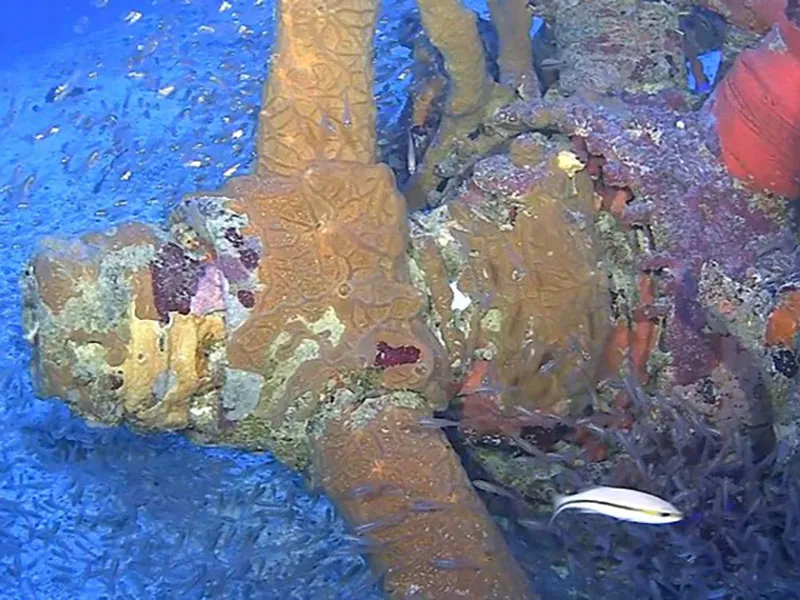Three U.S. Planes Lost During World War II Found in Pacific Lagoon
Project Recover, a nonprofit dedicated to locating MIA service members, identified the planes’ location
:focal(388x171:389x172)/https://tf-cmsv2-smithsonianmag-media.s3.amazonaws.com/filer/98/01/98014643-843d-422d-9b5b-59129b8090ae/wreck.jpg)
Researchers from Project Recover, a joint endeavor of the University of Delaware and the University of California, San Diego, that aims to “find and repatriate Americans missing in action since World War II,” recently located the wreckage of three U.S. military aircraft lost during a February 1944 battle in the conflict’s Pacific theater.
The team discovered the two SBD-5 Dauntless dive bombers and one TBM/F-1 Avenger while searching Truk Lagoon in the Chuuk State of Micronesia, per a statement. Seventy-six years ago, the body of water was the site of Operation Hailstone, a two-day Allied air assault on a Japanese naval base. More than 50 Japanese ships and 230 total aircraft, 30 of which were American, were lost in the depths of the lagoon during the skirmish.
An airplane gunner’s account of the operation helped Project Recover spot the U.S. planes, which can be difficult to pick out among the array of coral-covered debris found at the bottom of Truk Lagoon.
As Project Recover historian Colin Colbourn tells Live Science’s Mindy Weisberger, the gunner saw a Dauntless dive bomber fall while firing on a Japanese transport ship, which also sank.
“We were able to line up this piece of the puzzle with this other piece of the puzzle, in order to say, ‘OK, let’s focus our search around this ship,’” says Colbourn. “And that was actually where we ended up finding this airplane.”
/https://tf-cmsv2-smithsonianmag-media.s3.amazonaws.com/filer/7b/88/7b883f34-3521-4909-a564-339323ac0ac9/1581615001608.jpg)
The research team conducted four expeditions between April 2018 and December 2019. Using an autonomous robot that completed repetitive sonar scans of the ocean floor, the group surveyed about 27 square miles of the lagoon, identifying signs of unnatural debris in 61 sites. Divers and robots carrying cameras investigated the area further and found debris fields littered with the aircraft’s remains at depths of between 100 to 215 feet.
Truk Lagoon’s numerous sunken Japanese ships, some of which still hold airplanes and trucks, make it a popular scuba diving destination, according to Live Science. But the researchers aren’t surprised that the planes went unnoticed for so long.
“When these aircraft crash into the water, they don’t look like aircraft anymore,” Mark Moline, expedition leader and director of the University of Delaware’s School of Marine Science and Policy, tells Dylan Gresik of Military Times. “Most of them are piles of metal that don’t rise very far off the bottom [of the ocean]. The exception is the propeller, usually sticking out.”
Typically, the team compares historical records of aircraft that went missing during military operations to debris recovered in a specific region. In this case, Colbourn tells Military Times, records showed only two Dauntless dive bombers lost in the area searched.
After identifying wrecks, researchers determine which service members were piloting the vessels during a given battle. Once the aircraft’s debris fields have been archaeologically surveyed, the project team gives the data to the U.S. Defense P.O.W./M.I.A. Accounting Agency, which handles attempts to recover servicemen’s remains.

“What we’ve seen is that the cockpit area is somewhat intact, so the potential is that the remains could be there,” says Daniel O’Brien, one of Project Recover’s directors, to the New York Times’ John Ismay. “The bodies could have been ejected or floated away, but there’s a good chance the remains are still with the aircraft.”
Including the latest finds, Project Recovery has located 28 aircraft and ensured the repatriation of 13 sets of remains to date.
The researchers plan on continuing their work at Truk Lagoon, which may house the wrecks of 33 aircraft carrying almost 100 missing service members, Colbourn tells Military Times. They also want to travel to Kuwait to look for a Navy A-6 Intruder lost in the Persian Gulf during Operation Desert Storm in 1991, per the New York Times.
Around 79,000 American service members went missing during World War II. Today, more than 72,000 remain unaccounted for.
“Even though we are focused on finding aircraft, the aircraft really aren’t our interest,” Moline tells Military Times. “We are only doing this to return and identify MIAs. That’s really our core mission. The main headline is bringing our guys home.”